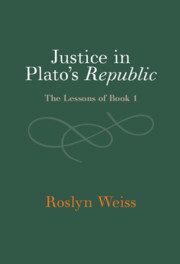Refine search
Actions for selected content:
30 results
Enemies
-
- Journal:
- Journal of the American Philosophical Association , First View
- Published online by Cambridge University Press:
- 11 August 2025, pp. 1-18
-
- Article
-
- You have access
- Open access
- HTML
- Export citation
Chapter 4 - Pétrus, Dante, Pierre and Bernard
- from Part I - Finding One’s Way
-
-
- Book:
- Boulez in Context
- Published online:
- 08 July 2025
- Print publication:
- 24 July 2025, pp 36-46
-
- Chapter
- Export citation
8 - How Do Children Think About Groups?
- from Section II - Middle Childhood
-
- Book:
- Child Development
- Published online:
- 19 June 2025
- Print publication:
- 12 June 2025, pp 122-136
-
- Chapter
- Export citation

Justice in Plato's Republic
- The Lessons of Book 1
-
- Published online:
- 24 January 2025
- Print publication:
- 16 January 2025
4 - Why Is Social Interaction So Important?
-
- Book:
- Brain Boost
- Published online:
- 23 January 2025
- Print publication:
- 23 January 2025, pp 47-56
-
- Chapter
-
- You have access
- HTML
- Export citation
Chapter 3 - Polemarchus
-
- Book:
- Justice in Plato's <i>Republic</i>
- Published online:
- 24 January 2025
- Print publication:
- 16 January 2025, pp 52-91
-
- Chapter
- Export citation
14 - Adolescent Disclosure with Parents versus Siblings and Friends
- from Part III - Informant and Contextual Differences in Disclosure and Secrecy
-
-
- Book:
- The Cambridge Handbook of Parental Monitoring and Information Management during Adolescence
- Published online:
- 12 December 2024
- Print publication:
- 19 December 2024, pp 282-302
-
- Chapter
- Export citation
Chapter 10: - Relationships
-
- Book:
- Adultish
- Published online:
- 10 October 2024
- Print publication:
- 01 August 2024, pp 181-202
-
- Chapter
- Export citation
Chapter 23 - Wagner’s Finances
- from IV - Life, Language, and the Ancient World
-
-
- Book:
- Wagner in Context
- Published online:
- 14 March 2024
- Print publication:
- 14 March 2024, pp 229-238
-
- Chapter
- Export citation
14 - Friendships
- from Part 2 - Dimensions of health and wellbeing
-
-
- Book:
- Health and Wellbeing in Childhood
- Published online:
- 08 March 2024
- Print publication:
- 04 March 2024, pp 224-238
-
- Chapter
- Export citation
The association between neighborhood-level social fragmentation and distressing psychotic-like experiences in early adolescence: the moderating role of close friends
-
- Journal:
- Psychological Medicine / Volume 54 / Issue 9 / July 2024
- Published online by Cambridge University Press:
- 16 February 2024, pp. 2172-2180
-
- Article
- Export citation
6 - Social Support
-
- Book:
- Resilience
- Published online:
- 01 August 2023
- Print publication:
- 07 September 2023, pp 105-122
-
- Chapter
- Export citation
Employment over the life course and post-retirement social networks: a gendered perspective
-
- Journal:
- International Psychogeriatrics / Volume 36 / Issue 8 / August 2024
- Published online by Cambridge University Press:
- 18 July 2023, pp. 655-665
-
- Article
-
- You have access
- Open access
- HTML
- Export citation
6 - Lifestyle Ebbs and Flows
-
- Book:
- The Love Jones Cohort
- Published online:
- 02 February 2023
- Print publication:
- 09 February 2023, pp 83-98
-
- Chapter
- Export citation
3 - The Patient’s Voice
-
- Book:
- Emotions and Surgery in Britain, 1793–1912
- Published online:
- 13 October 2022
- Print publication:
- 20 October 2022, pp 109-148
-
- Chapter
-
- You have access
- Open access
- HTML
- Export citation
5 - An Experiment in International Cooperation
-
- Book:
- Uniting Nations
- Published online:
- 08 July 2022
- Print publication:
- 28 July 2022, pp 124-151
-
- Chapter
- Export citation
4 - Inner Circle
- from Part I - Trump’s Tribe
-
- Book:
- The Enablers
- Published online:
- 03 September 2021
- Print publication:
- 19 August 2021, pp 71-90
-
- Chapter
- Export citation
The experience of close personal relationships after stroke: scoping review and thematic analysis of qualitative literature
-
- Journal:
- Brain Impairment / Volume 23 / Issue 3 / December 2022
- Published online by Cambridge University Press:
- 02 August 2021, pp. 231-261
-
- Article
- Export citation
The maintenance of friendships after severe traumatic brain injury
-
- Journal:
- Brain Impairment / Volume 22 / Issue 1 / March 2021
- Published online by Cambridge University Press:
- 14 October 2020, pp. 79-91
-
- Article
- Export citation
Positive Psychosocial Factors and Cognitive Decline in Ethnically Diverse Older Adults
-
- Journal:
- Journal of the International Neuropsychological Society / Volume 27 / Issue 1 / January 2021
- Published online by Cambridge University Press:
- 25 August 2020, pp. 69-78
-
- Article
- Export citation
